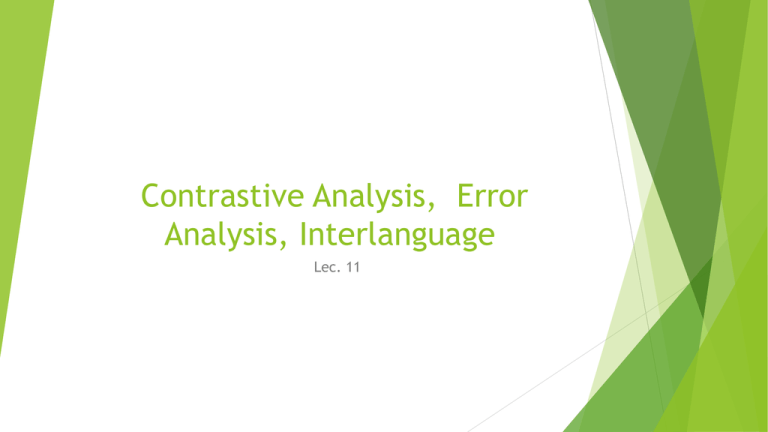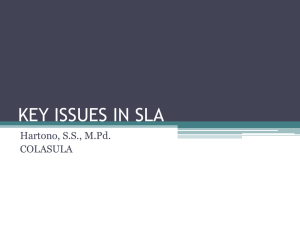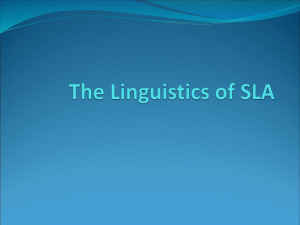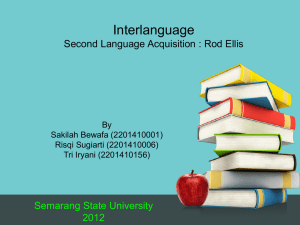CA, EA, & IL 11
advertisement

Contrastive Analysis, Error Analysis, Interlanguage Lec. 11 1. Contrastive Analysis CA CA is an approach to the study of SLA which involves predicting and explaining learner problems based on a comparison of L1 & L2 to determine structural similarities & differences. Contrastive Analysis CA CA & linguistic and psychological theories 1940s & 1950s (structuralism & behaviorism) The goal of CA was primarily pedagogical in nature: to increase efficiency in L2 teaching and testing. Robert Lado & Linguistics Across Cultures (1957) The plan of the book: We can predict and describe the patterns that will cause difficulty in learning, and those that will not cause difficulty, by comparing systematically the language and culture to be learned with the native language and culture of the student. CA & Structuralism Following structuralist linguistics, the focus of CA is on the surface forms of both L1 & L2 systems, and on describing and comparing the languages on the level at a time (phonological/morphological/syntactic/lexical aspect). A bottom-up analysis (small large) Fries & his claims on L2 teaching CA& Behaviorism Language acquisition essentially involves habit formation in a process of Stimulus-Response-Reinforcement (S-RS). Learners imitate and repeat the language that they hear. Contrastive Analysis CA Transfer learning: 1. Positive transfer 2. Negative transfer Interference) The process of CA Describing L1 & L2 at each level Analyzing comparable segments of the languages for elements which are likely to cause problems for learners This information provides a rationale for constructing language lessons Lado’s assumptions 1. The easiest L2 structures are those which exist in L1 with the same form, meaning, and distribution and are thus available for positive transfer. Lado’s assumptions 2. Any structure in L2 which has a form not occurring in L1 need to be learned, but this is not likely to be very difficult if it has the same meaning and distribution as an ‘equivalent’ in L1. Lado’s assumptions 3. Among the most difficult are structures where there is partial overlap but not equivalence in form, meaning, and / or distribution and these are the most likely to cause interference. Types of Interference: Spanish & English same form & meaning, different distribution English The white dove The white doves Spanish La paloma blanca Las palomas blancas Types of Interference: Spanish & English same meaning, different form English I will go Spanish iré Types of Interference: Spanish & English same meaning, different form & distribution English Water Spanish agua CA The process of CA can be applied to any L1 & L2, but analysts cannot assume that such specifics as definitions of types of interference in Spanish & English will be relevant for languages with different typological features. E.g. All languages inflecting nouns for plural will be contrasted with languages inflecting verb for number, or with languages using no grammatical marker for number at all. CA While CA highlighted potential learning problems, behaviorist learning theory attributed variable success by L2 learners in part to the nature of the relationship between L1 & L2, but most importantly to circumstances of learning which promote poor versus good habit formation . The CA of the 1940s & 1960s, & SLA 1. The CA of the 1940s & 1960s was not adequate for the study of SLA because: The behaviorist learning theory to which it was tiedcannot explain the logical problem of language learning. The CA of the 1940s & 1960s, & SLA 2. The CA analyses were not always validated by evidence from actual errors. Many of the L2 problems which CA predicts do not emerge; CA does not account for many learner errors, and much predicted positive transfer does not materialize. The CA of the 1940s & 1960s, & SLA But, CA 1. Stimulated the preparation of hundreds of comparative grammars, and 2. Its analytic procedures have been usefully to descriptive studies and to translation, including computer translation. 2. Error Analysis EA (1970s) Error analysis EA is the first approach to the study of SLA which includes an internal focus on learners’ creative ability to construct language. it is based on the description and analysis of actual learner errors in L2., rather than on idealized linguistic structures attributed to native speakers of L1 & L2 Error Analysis EA replaced CA by the early 1970s because of the following developments: Overprediction of errors Underprediction of errors A change in linguistic theory: structural linguistics underlying structures Being based on the notion of habit formation: Behaviorism Nativism The developing distinction between L2 teaching & L2 learning: learning process Error Analysis Behaviorism Nativism Language thus came to be understood as a rule-governed behavior The child is an active participant and not a passive recipient 3. EA Approach For the first time, Learners errors are not bad habits but sources of insight into the learning process According to Corder (1967) 1. Errors are windows into the language learner’s mind (transitional competence) 2. The making of errors is significant because it is part of the learning process itself 3. EA Approach For the first time, Learner language is viewed as a target of analysis which is potentially independent of L1 & L2, and the state of learner knowledge is seen as transitional competence on the path of SLA EA Methodology The procedure for analyzing the learner errors includes the following steps: 1. Collection of a sample learner language 2. Identification of errors 3. Description of errors 4. Explanation of errors 5. Evaluation of errors EA Criticism EA is mainly criticized for a number of shortcomings: 1. Ambiguity in classification (interlingual? interalingual? L1 influence?) 2. Lack of positive data 3. Potential for avoidance 4. Influence of L2 curricula 3. Interlanguage IL (1970s) Selinker (1972) introduced the term Interlanguage IL to refer to the intermediate states of a learner’s language/ system as it moves toward the L2. This linguistic approach has been names different terms, such as transitional competence, interlanguage, and approximative systems IL Assumptions 1. Learners construct a linguistic system, which is different form L1 & L2, but based on L2 input. 2. Learners reconstruct and approximate a certain variety of L2 that rarely becomes identical to the L2 norm IL Characteristics IL has the following characteristics: 1. Systematic 2. Dynamic 3. Variable 4. Reduced system in both form & function IL & L1 Selinker (1972) and the difference between IL development in SLA & La in children (cognitive processes): 1. Language transfer form L1 to L2 2. Transfer of training, or how L2 is taught 3. Strategies of L2 learning 4. Strategies of L2 communication 5. Overgeneralization of the target language linguistic material 6. Fossilization & age of learning IL & Methodology Selinker identified a number of essential components for IL analysis: 1. L1 utterances uttered by the learner 2. IL utterances produced by the learner 3. L2 utterances produced by native speakers IL Criticism 1. No concrete hints in the literature on how to describe the changing linguistic system in IL 2. A large body of data is needed to ascertain a linguistic rule in the learner’s IL, and this only achieved through longitudinal studies in order to follow the development of language. 3. Observation of the most truly systematic of a learner’s IL is not an easy process since it needs a number of considerations related to social status of both the learner & the researcher (topic, classroom, monitored speech, etc.)










